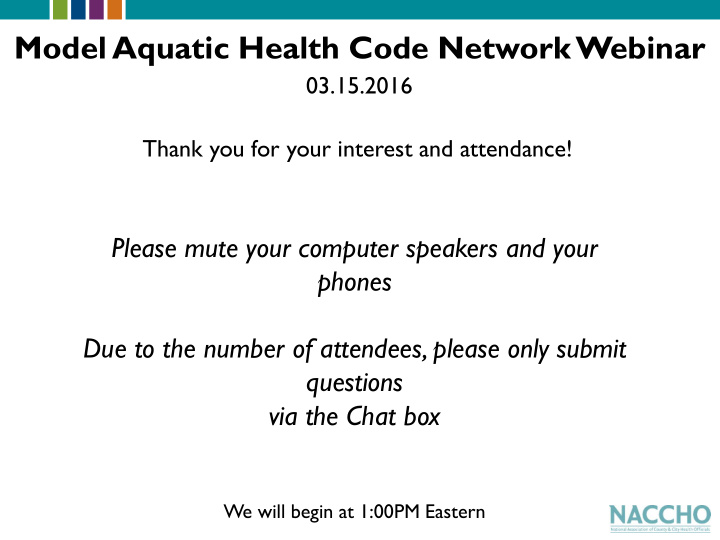



Model Aquatic Health Code Network Webinar 03.15.2016 Thank you for your interest and attendance! Please mute your computer speakers and your phones Due to the number of attendees, please only submit questions via the Chat box We will begin at 1:00PM Eastern
Agenda Time T opic Speakers 1:00-1:10PM Introductions Jennifer Li, NACCHO Jasen Kunz, CDC Doug Sackett, CMAHC 1:10-1:35 Featured Speaker Eugene Knight, New Mexico 1:35-2:00PM Q&A Open to All • Submit questions via chat
MAHC Work at NACCHO Jennifer Li, NACCHO jli@naccho.org
MAHC Profiles • 8 local health departments • Benefits o evidence based, standardized inspection reports • Concerns o large document o need additional resources, time, and funding • Resource Needs o educating stakeholders, training support, toolkits, examples, mentorship
Model Aquatic Health Code Network • Increase awareness, peer-to-peer networking, and use of MAHC among health departments; • Apply knowledge of challenges and successes from health departments; • Expand use of the MAHC among states and localities; and • Provide resources needed by local and state health departments to use the code.
MAHC Session at NEHA 2016 • 90 Minute Learning Session • Open discussion, interactive • Roundtable Topics: • MAHC Implementation Support • CMAHC 101 • Adoption Stories from the Field • MAHC Inspector Training & Data Use
MAHC Work at CDC Jasen Kunz, CDC izk0@cdc.gov
DOUGLAS SACKETT DOUGLASSACKETT@CMAHC.ORG
The Conference for the Model Aquatic Health Code (CMAHC) What is CMAHC ? 501c(3) non-profit organization Why does it exist ? Established in 2013 to manage updates to the MAHC Administration & Operation Bylaws, Board of Directors, Executive Director Committees include Technical Review Committee and Ad Hoc Committees
The Conference for the Model Aquatic Health Code (CMAHC) Mission Collect, assess, and relay input on MAHC revisions back to CDC for final acceptance Provide advocacy and needed support to health departments and other partners on using the MAHC Solicit, coordinate, and prioritize research needs
Website Information Website: www.cdc.gov/mahc Website: www.cmahc.org Email: info@cmahc.org Email: mahc@cdc.gov
MEMBERSHIP: HOW TO BECOME A CMAHC MEMBER
Swimming Pool Program Manager Environmental Health Bureau New Mexico Environment Department
Background Environmental Health Bureau has jurisdiction over the State of New Mexico Public Pools. Exceptions to Jurisdiction are the City of Albuquerque and Tribal Lands The Bureau regulates the design, construction, and the operation of public pool. 2015 the Bureau had 1066 vessel under our program
Background The New Mexico Environment Department inspects all public swimming pools and spas, including pools and spas at: • Apartment Complexes • Home Owners Associations • Motels/Hotels • Health Clubs • Condominiums • Municipal Pools • Bed and Breakfasts • RV Parks • Colleges and Universities • Organizational Camps • and others specified in 7.18.2 NMAC
Regulatory Authority New Mexico has had Swimming Pool Regulation since 1937 and have been updated 9 times with 2008 as the most recent update. The Swimming Pool Regulations were administered by various State organizations until 1974 when the Environmental Improvement Board was enacted. 2014 decision was made to adopt the MAHC as New Mexico Swimming Pool Regulations.
Regulatory Authority: Passing Regulations in New Mexico The New Mexico Legislator has granted the Environmental Improvement Board the authority to proclamate rules and regulations. The Board has a public hearings on proposed changes to the regulation. They review and hear evidence, then approve or deny or make changes to the proposed regulations. 60 days after approval by the Board and publication in the State Register the new regulations become effective.
Challenges/Hurdles Comparing the current pool regulations to the MAHC Deciding what changes to make to the MAHC to fit New Mexico’s current regulations and way of doing business. Obtaining approval from New Mexico Environment Department officials to proceed with the adoption of the MAHC. Communication with regulated entities to provide notice and information regarding the regulation change.
Challenges/Hurdles Working with New Mexico Environment Departments office of General Council. Keeping the New Mexico Environment Departments Pool Program web page up to date on proposed changes Organizing public meetings throughout the State. Drafting and mailing out notice to all pool owners to inform them of the proposed regulatory changes. Updating proposed regulations after public comment.
Successes Obtained the New Mexico Environment Departments upper management's approval to procced. Public meetings were successful: Good attendance Received several public comments Regulated community has been receptive to the adoption of the MAHC as the main part of new regulations.
Partners/Resources CDC: The CDC has been a major contributor in this endeavor by the development of the MAHC and the supplemental informational materials they have produced. CMAHC CMAHC is another resource for people to obtain information on the MAHC and how it will be kept updated.
Adoption of MAHC Proposed regulations are incorporating the MAHC with a few changes Aquatic venue definition to fit our pool classification structure Omitted sections that were in conflict with our administrative requirements Omitted water replenishment section Placed upper limit on bromine of 8ppm Extended period for installing automated controllers to two years for current venues.
Status The proposed regulations have completed the public meeting process. The proposed regulations have been presented to the Environmental Improvement Board which scheduled public hearing on May 13, 2016. If approved by the Board the new Public Aquatics Venue Regulations will become effective July 1,2016.
Next Steps Educating New Mexico's inspectors and regulated public on the changes to the New Mexico Public Aquatic Venue Regulations Developing template plans Grace periods? Compliance assistance?
Thank you! • A short evaluation survey will be sent • Want to join the MAHC Network? • Email your name and affiliation to mahcnet@naccho.org
Recommend
More recommend